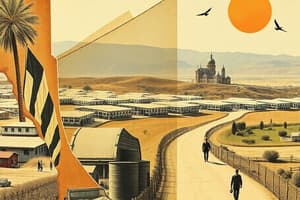Podcast
Questions and Answers
What factor contributed to California's agricultural industry becoming a leading producer of fruit?
What factor contributed to California's agricultural industry becoming a leading producer of fruit?
- Introduction of synthetic fertilizers
- Skilled labor force from Europe
- Access to large foreign markets
- Ideal climate and diverse soil conditions (correct)
Which event led to a significant population boom in California during the 1880s?
Which event led to a significant population boom in California during the 1880s?
- The California Gold Rush
- Introduction of rail freight tariffs
- Completion of the transcontinental railroad (correct)
- Discovery of oil
How did the agricultural industry impact California's population dynamics?
How did the agricultural industry impact California's population dynamics?
- It significantly reduced the state's agricultural workforce.
- It caused a decrease in urbanization.
- It led to an immigration wave and new town development. (correct)
- It resulted in the abandonment of farming practices.
What led to the rise of Hollywood as the heart of the film industry?
What led to the rise of Hollywood as the heart of the film industry?
What was a direct consequence of California's wheat boom in the late 1800s?
What was a direct consequence of California's wheat boom in the late 1800s?
Which of the following best describes a major influence of the Southern Pacific Railway on California's economy?
Which of the following best describes a major influence of the Southern Pacific Railway on California's economy?
Which industry had its growth linked to the completion of the transcontinental railroad in California?
Which industry had its growth linked to the completion of the transcontinental railroad in California?
What was a significant outcome of California's integration into world markets through its agricultural exports?
What was a significant outcome of California's integration into world markets through its agricultural exports?
Flashcards
California Gold Rush
California Gold Rush
The period when gold was discovered in California (1848-1855) and miners flocked to the state, leading to rapid population growth and significant economic impact.
California Wheat Boom
California Wheat Boom
The period following the Gold Rush, where California saw a surge in wheat production (1850s-1890s) due to ideal conditions and its export to Europe.
California Fruit Cultivation
California Fruit Cultivation
California evolved from wheat production to become one of the leading fruit producers worldwide, cultivating grapes, citrus, olives, and more (1890 onwards).
California Depression of 1870s
California Depression of 1870s
Signup and view all the flashcards
California Tourism Boom
California Tourism Boom
Signup and view all the flashcards
Hollywood Film Industry
Hollywood Film Industry
Signup and view all the flashcards
Agriculture's Influence on California's Development
Agriculture's Influence on California's Development
Signup and view all the flashcards
Tourism and Entertainment in California's Development
Tourism and Entertainment in California's Development
Signup and view all the flashcards
Study Notes
Major Economic Influences in California's Development
-
Agricultural Industry:
- Initially fueled by the Gold Rush (1848-1855), then a wheat boom (1850s-1890s).
- California's geographical advantages (flat terrain, fertile soil) and climate facilitated wheat cultivation.
- Became a major exporter of wheat to European markets, fostering global integration.
- Surpassed Midwest/Eastern wheat production through innovative methods (labor-saving technology, animal power, specific wheat varieties).
- Transitioned from wheat to fruit cultivation (grapes, citrus, olives, lemons, plums), becoming a global leader.
- Extensive labor demand spurred population growth, immigration, and urban development.
-
Tourism and Entertainment Industry:
- Overcame an 1870s depression through railway advertising campaigns.
- The Southern Pacific Railway targeted Midwest residents, creating a substantial flow of travelers.
- A reduction in travel costs from $125 to $1 attracted a wave of migrants.
- The 1880s wheat boom intensified this growth, leading to urban centers like Los Angeles.
- Hollywood's emergence as a film production hub (1900s) due to:
- Consistently sunny climate and diverse locations.
- Geographical distance from Thomas Edison's patent company (preventing lawsuits).
- Film production spurred population growth in LA, boosting other industries (oil, aviation).
- Hollywood's rise transformed a small village into a global entertainment center, significantly impacting the population.
Studying That Suits You
Use AI to generate personalized quizzes and flashcards to suit your learning preferences.
Description
Explore the major economic influences in the development of California, focusing on its agricultural industry and tourism sector. Learn how the Gold Rush and innovations in agriculture transformed California into a leading exporter. Additionally, discover how transportation advancements shaped the state's tourism and entertainment industry.




